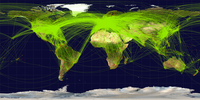
Photo from wikipedia
Political, economic, commercial and social factors have considerable impact in shaping health outcomes. Yet, most research is hypothesis-driven and, probably, not fully exploring the available data. We aimed at adapting… Click to show full abstract
Political, economic, commercial and social factors have considerable impact in shaping health outcomes. Yet, most research is hypothesis-driven and, probably, not fully exploring the available data. We aimed at adapting gene expression profiling methods to perform unsupervised high-throughput profiling analysis of large databases of country indicators associated with life expectancy at birth. We analysed 464 World Bank development indicators for 217 countries using a Limma software R package. We established the differentially represented indicators (DRIs) between countries in the first and third terciles of life expectancy at birth. The analysis was stratified according to high (HIC), middle- (MIC) or low-income (LIC) status. Indicator profiles by development category were compared to determine overlaps and group-specific DRIs. Confounder-adjusted multivariable linear regression models were used to validate chosen DRIs. We identified 99 DRIs for HICs, 7 for MICs and 190 for LICs. One DRI was common to all categories - “particulate emission damage (% of GNI)” (adjusted p.value=7.3E-5). This DRI was negatively associated with life expectancy despite adjustment for GDP per capita (GDP), human capital index (HCI) and development classification (Beta=-2.7, p < 0.001). We also analysed the 7 identified gender-related DRIs. Only female murder rate (per 100 000 females) was negatively associated with life expectancy, independently of GDP, HCI, GINI index, education parity indexes, overall and male murder rates (Beta=-2.1, p = 0.001). This association was found in HICs (p = 0.001) and MICs (p = 0.03), but not in LICs (p = 0.4). Bioinformatics methods could help to analyse large country level datasets, allowing the profiling of DRIs and identify potential new determinants of health or health-associated indicators. Using bioinformatics tools can be useful in uncovering health-associated indicators for global health. Particulate emission damage or female murder rate could represent potential important determinants of health or health-associated indicators.
Journal Title: European Journal of Public Health
Year Published: 2019
Link to full text (if available)
Share on Social Media: Sign Up to like & get
recommendations!